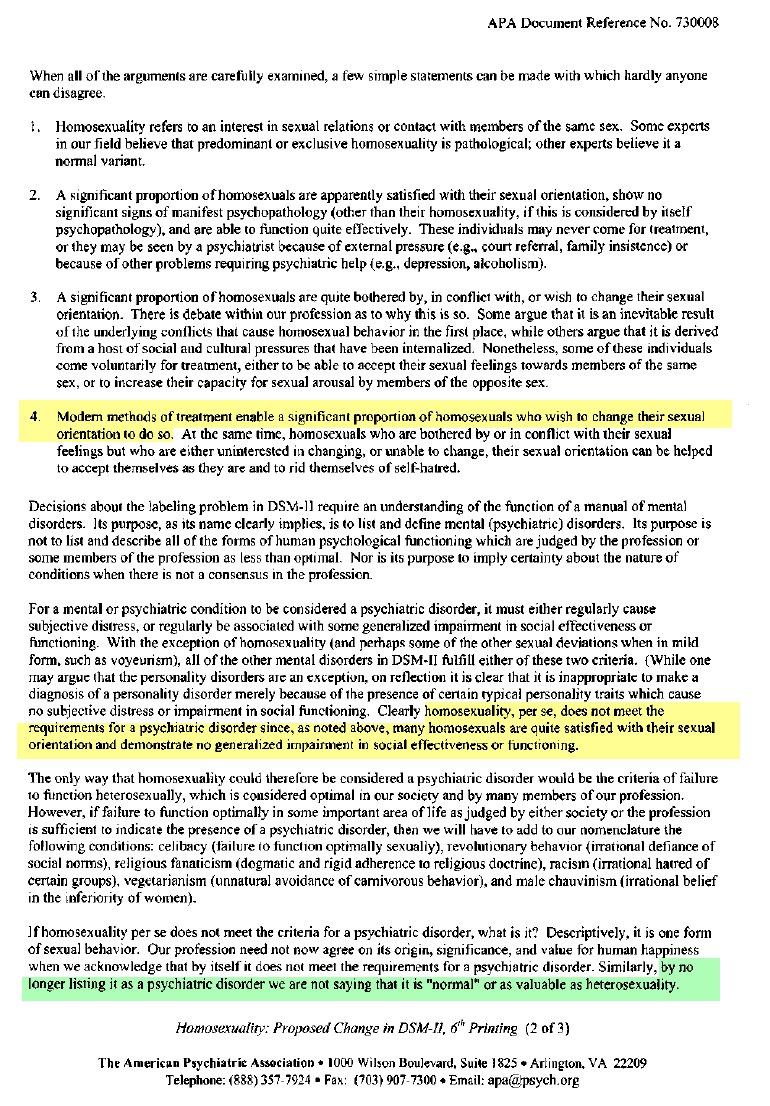In addition to the refuted myths about the innate and normality of homosexuality, gay activists managed to launch the myth of its immutability. You can often hear that attempts to change sexual orientation are harmful because lead to shame, depression, and sometimes suicide (which is not confirmed by research). As an example, Turing’s death is usually presented to us as “suicide” associated with hormone therapy. According to the bbc science department, the version of his suicide does not hold water, and most likely, he accidentally poisoned himself with cyanide, which he constantly used for electrolysis. According to Turing Biography Expert Professor D. Copland: “He reacted to hormone therapy with great humor, and his career was at the peak of intellectual heights. "He was in a good mood the days before his death, and even had a fun party with his neighbors."
In any case, hormone therapy (chemical castration) cannot be compared with psychoanalytic reparative therapy, which is aimed at developing male gender identity and eliminating psychological trauma of childhood. Depression due to an unsuccessful attempt to change orientation is certainly possible, as with any other failure, but in fact most suicide attempts are due to misinformation spread by gay movement leaders that orientation cannot be changed. For example: http://www.bbc.com/news/world-…
THEORY BASED ON PSYCHODYNAMIC REPAIR THERAPY.
In dynamic psychotherapy, homosexuality is seen as a “unit of neurosis”, i.e. a psychogenic disorder of a reversible nature resulting from an unfavorable solution to deep psychological conflicts or injuries. Injuries can be overt, such as sexual or emotional abuse, or be created by subjective impressions on the standard negative situations that every child faces. Dynamic psychotherapy identifies, isolates and solves these traumatic experiences, which leads to a reduction and sometimes elimination of unwanted homosexual tendencies.
The National Association for the Study and Therapy of Homosexuality (NARTH) describes the following pattern of same-sex attraction:
In a child with hypersensitivity, strong emotional experiences can disrupt the development of his gender identity, which in 8 cases from 10 will lead to attraction to his own sex, which will become erotic in the course of puberty. We erotize what is not connected.
The lack of approval, attention, and favor on the part of male figures can be compensated for through sexual relations with them. In another scenario, a shy feminine teenager enviously looks at a courageous, self-confident and popular peer - the embodiment of a desired unattainable ideal, and in his desire to have the same qualities, he begins to sexualize their possessor. His erotic attraction is an attempt to possess the desired qualities, even in such a symbolic form. Sometimes a relationship with an adult male is designed to make up for the lack of paternal relationships.
Reparative therapy develops the heterosexual potential of such a person, introduces him to his own masculinity and allows him to maintain intimacy and friendship with his sex without his sexualization.
The courageous type of homosexual has the same sense of lack of courageous identity as the feminine type, with the only difference being that the early environment of cruel humiliation taught him not to show weakness and hide his own vulnerability under the guise of a macho man. Here there is a protective mechanism of "reaction formation" by which an unacceptable impulse is overcome by exaggerating the opposite tendency. Since such an adaptation of qualities is not the result of a process of natural development, it, as a rule, is a grotesque and hypertrophic parody of an imaginary standard. So there are caricature barbel in leather caps and transvestites, with their makeup and grimaces more like clowns than women.

The courageous type of homosexual consoles a frightened boy inside himself by seeking closeness with a younger and less courageous partner, representing a depressed part of himself that had to be denied in childhood in order to survive.
Therapy in this case will be aimed at rejecting the false hyper-masculine facade and revealing its true male self. This process also requires the resolution of childhood trauma of abuse and intimidation, which eliminates the need to repeat their compensatory sexual fantasies.
The transition from homosexuality to heterosexuality should not be seen as a question of "either one or the other." There is a certain continuum, that is, a slow, progressive decrease in homosexual drives and an increase in heterosexual qualities and opportunities, the degree of manifestation of which varies widely. It should be noted that there are many diverse reasons leading to various conditions in which attraction to one's own sex can occur. The above model describes only one of the most common etiologies of homosexuality and does not claim universality. A person can be involved in homosexual relationships for a variety of reasons, from mental disabilities to teenage nihilism. His homosexual feelings may be rooted in the need for acceptance, approval, affection, or reflect his loneliness, boredom, or mere curiosity. A teenager may engage in same-sex sexual behavior for the sake of adventure, money, under peer pressure, or under the influence of the media. This may be an expression of revenge on parents, hostility towards men, or re-experiencing the trauma of sexual harassment.
EFFICIENCY OF REPAIR THERAPY.
Review experimental data, clinical reports, and research over the past 135 years convincingly demonstrate that motivated men and women can move from homosexuality to heterosexuality. Various approaches have been used to treat homosexuality, including psychodynamic, cognitive-behavioral treatments and pastoral leadership. There is evidence of spontaneous change without any intervention.
What do the academy say about this.
In 1956, the outstanding psychiatrist of the time was Edmund Bergler писал following:
“10 years ago, the best science could offer was reconciliation of a homosexual with his“ fate ”, in other words, the elimination of a conscious guilt. Recent psychiatric experience and research has unequivocally proven that the supposedly irreversible fate of homosexuals (sometimes even attributed to non-existent biological and hormonal conditions) is in fact a therapeutically altered unit of neurosis. Today, psychoanalytic psychotherapy can cure homosexuality. Can we cure every homosexual? - Not. Certain prerequisites are necessary, and most importantly, the desire of a homosexual to change. This disorder, at first glance sexual, is invariably combined with serious subconscious self-destruction, which inevitably manifests itself outside the sexual sphere, as it covers the entire personality. The real enemy of a homosexual is not his perversion, but his ignorance that he can be helped, plus his mental masochism, which makes him avoid treatment. This ignorance is artificially supported by homosexual leaders. ”
Over the 30 years of practice, Bergler has helped roughly 100 homosexuals change their orientation. It describes the complete success in 33% of cases.
Irving Bieber, completing in 1962 nine-year research 106 homosexuals said that 27% of them became completely heterosexual as a result of psychoanalytic therapy, including those who were previously completely homosexual. In 1979, he said that about 1000 homosexual men had turned to him all the time and that the data was in accordance with the initial study.
"Patient follow-up over the next 20 years has shownthat they remained exclusively heterosexual, and reorientation rates ranged from 30% to 50%. ”
Daniel Kappon in 1965 сообщил about the results of their clinical work with 150 patients: 50% of homosexuals, 30% of lesbians and 90% of bisexuals became heterosexual.
When the APA depatologized homosexuality in 1974, she stated that “Modern treatment methods allow a significant part of homosexuals who want to change their sexual orientation to do so”.

After APA turned into a political organization with anti-scientific claims of gay activists in its official publications, it not only ignores existing research on orientation changes, but also actively suppresses new ones, as the results will undoubtedly be in contradiction with its current policy. This is exactly what happened in a study by Szydlo and Schroeder, which was supposed to document the harm and futility of reparative therapy, but in fact found evidence to support its effectiveness for some people.
In 2004, APA's former president and member of her gay and lesbian affairs department, Robert Perloff condemned APA’s unilateral political activism called the attempts to discredit reparative therapy “irresponsible, unscientific, and intellectually defective.”
Perlof noted a growing body of research that contradicts the popular assertion of the impossibility of changing sexual orientation and supported the NARTH position.
Another APA Ex-President, Nicholas Cumings, at 2005 Conference of the Year сообщилbetween 1959 – 1979 18,000 homosexuals came to his clinic with various problems, of which approximately 1,600 aimed to change their orientation. As a result of 2,400 therapy, they were able to do this.
Leading scientist Jeffrey Satinover in 1996 писал about 50% success in a random sample, and about 100% success in a “carefully selected group of highly motivated individuals.”
Robert Spitzer, who personally excluded homosexuality from the list of psychiatric disorders in 1974, introduced in 2001 research, confirming that changing not only homosexual behavior and self-identification, but also sexual orientation is actually possible. Spitzer added that if his own son turned out to be gay and wanted to change, he would support him in the search for therapy and in attempts to change his orientation from homosexual to heterosexual.
Scott Hershberger, an outstanding scientist and statistician supporting the LGBT movement, after analyzing Spitzer’s research concludedthat it is strong evidence that reparative therapy can help people change their homosexual orientation to heterosexual.
“Now all those who are skeptical of reparative therapy should provide strong evidence to support their position.”
Some reports on successful reorientation in the psychoanalytic approach are summarized in the table:

American College of Pediatricians at 2008 said following:
“Although homosexual attraction is not necessarily a conscious choice, it is volatile for many people. Sexual reorientation therapy can be effective. ”
Researcher in developmental psychology, lesbian Lisa Diamond in interview 2015 of the year said the following:
“Sexuality is fickle. It's time to leave the idea of “born this way” behind. Gay rights should not depend on how a person became gay and we must accept the fact that sexuality can change."
Professor Camilla Paglia, feminist and lesbian, says same:
“Sexual orientation is fluid and can change.”
The variability of sexuality is confirmed by research. So about half of people with an exclusive same-sex attraction were once bisexual or even heterosexual, and about the same number of exclusive homosexuals became bisexual or even heterosexual. A similar shift in erotic preference is more common among homosexuals than heterosexuals. Neil Whitehead in Research 2009 showed that heterosexuality even at the age of 16-17 years is at least 25 more stable than bisexuality or homosexuality.
Freud in due time noticed, subconsciously, a homosexual has the same attraction for women as a normal person, but each time he ascribes his excitement to a male object. Modern research has confirmed the presence of sexual reactions in gay men to visual female stimuli.
A full report in 128 pages describing successful cases of reorientation will be available to those who wish to read here: https://vk.com/doc8208496_4467…
Summarizing the evidence available to date, we can say that on average, a third of the people who participated in the reorientation process report a transition to complete heterosexuality, a third report a significant shift towards heterosexuality and a general improvement in psychological well-being and social functioning, and a third report a lack of results. Awareness of the reasons for their attraction to their own sex and the underlying emotional needs, with the subsequent development of non-sexual relations with their own sex, have proved to be the most effective components in the transition to heterosexuality.
This site has collected more than a hundred testimonies of ex-gays - people who have left a homosexual lifestyle and become heterosexual. http://testpathvoc.weebly.com/
More about 80 certificates from another site: http://www.ldsvoicesofhope.or…
Site for the protection of ex-gay rights (they are greatly oppressed by the tolerant LGBT community): https://www.voiceofthevoiceles…
IT'S TIME TO LEAVE THE “BORN THIS WAY” ARGUMENT BEHIND.
After many years of research, the representative of the APA and LGBT communities, Dr. Lisa Diamond, presented the report that the sexual preferences of most homosexuals are constantly changing, and that the vast majority of them actually prefer the opposite sex.
“LGBT categories are arbitrary and meaningless,” says Diamond. They reflect the concepts that exist in our culture, but do not represent the phenomena that exist in nature. We used these categories as part of our strategy to obtain civil rights, and it is becoming very difficult now that we know that this is not true.
In order for a certain group of people to be able to obtain a protected status in the legal plan, it must be original and permanent. The Queer community does not meet the criteria of the Supreme Court for such a status, since it is incredibly diverse and inconsistent: some are completely homosexual, others partially; "one who was gay last year, this year may already not be him, etc."
This statement is completely contrary to recent laws passed in several US states prohibiting “reparative therapy”, on the basis that “homosexual orientation” is supposedly innate and fixed, and therefore attempts to change it are not only futile, but also cruel.
“LGBT people need to stop saying, 'help us, we were born this way and we can't change.' Sexuality is not fixed - it is fluid, and our opponents know this as well as we do. Therefore, it’s time to leave the idea of “born this way” behind and find better arguments for obtaining rights and privileges, otherwise it will come back to haunt us.”

It is scary that such people can be convinced that this is normal or even good, instead of treatment. Humanity will die out like that ...
Teorias velhas e ultrapassadas sobre a questão da homossexualidade continuam a ser desenterradas para tentar se dizer o que é eo que não é normal em termos de orientação sexual. Basta reconhecer que o ser humano, no início dos tempos fazia sexo com quem bem desejasse e isso nunca foi motivo de exclusão ou discriminação, pois não havia a regra da heteronormatividade, tudo era natural. Depois que a heterossexualidade foi colocada como regra, vieram estudos e teorias para tentar justificar essa regra que, no fundo, tem raiz religiosa. A sexualidade humana é diversa e não cabe em rótulos e definições restritas. Enfim, não existe o que é normal, em orientação sexual, portanto, nada tem que ser corrigido.
what a funny counter-propaganda)
on Wikipedia in the article same-sex marriage, a photo of lesbians from St. Petersburg, so one has a penis, she was a hetero guy before the transition, gender and orientation are not related, but the fact that some go into prostitution is a necessary measure
wow in St. Petersburg there is a lot of hidden homosexuality .. a lot
And links to ex-gay communities don't all work. Only one. And for a long time there were no new publications on the site